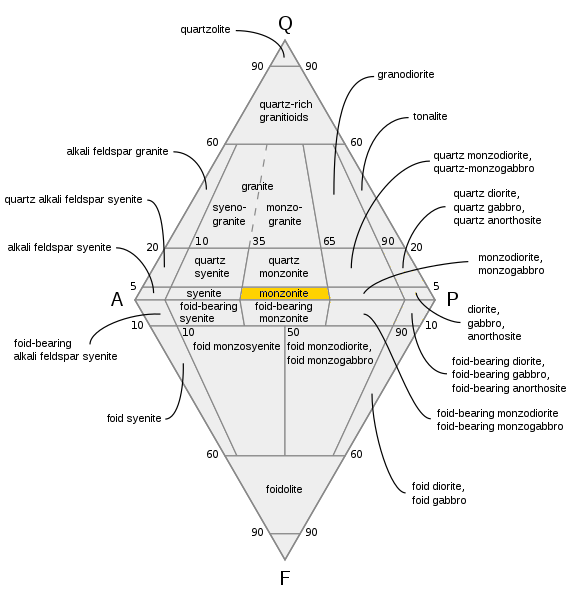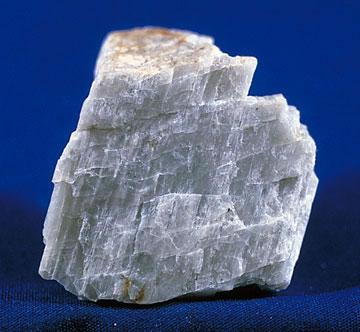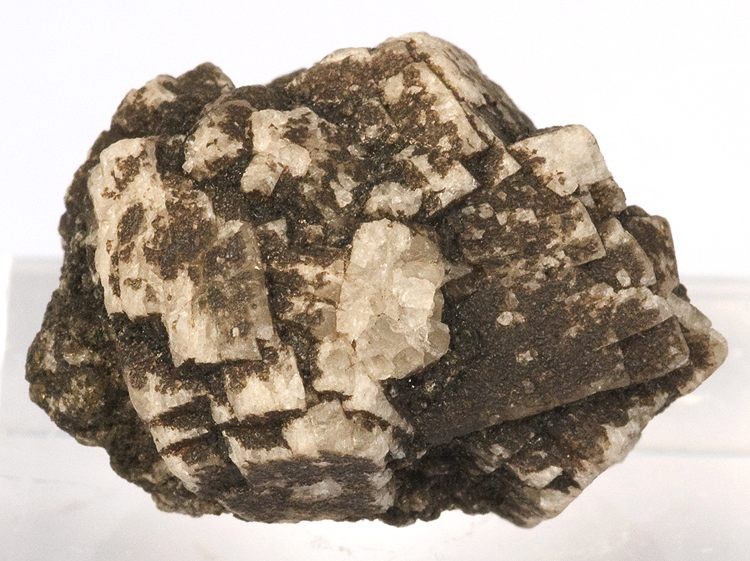|
Monzodiorite
Monzodiorite is an intrusive rock with a composition intermediate between diorite and monzonite. It is defined in the QAPF classification as coarse-grained igneous rock in which quartz makes up 0% to 5% of the QAPF mineral fraction, plagioclase Plagioclase ( ) is a series of Silicate minerals#Tectosilicates, tectosilicate (framework silicate) minerals within the feldspar group. Rather than referring to a particular mineral with a specific chemical composition, plagioclase is a continu ... makes up 65% to 90% of the total feldspar content, and the plagioclase is sodium-rich (% An < 50). References Plutonic rocks {{igneous-rock-stub ...[...More Info...] [...Related Items...] OR: [Wikipedia] [Google] [Baidu] |
Monzonite
Monzonite is an igneous intrusive rock, formed by slow cooling of underground magma that has a moderate silica content and is enriched in alkali metal oxides. Monzonite is composed mostly of plagioclase and alkali feldspar. Syenodiorite is an obsolescent term for monzonite or for monzodiorite.Le Maitre, R.W., ''Igneous Rocks: A Classification and Glossary of Terms'' Cambridge University Press, 2nd ed, pp. 113 Larvikite is a particular form of monzonite. Description Monzonite is a coarse-grained ( phaneritic) igneous rock. Such rocks are classified by their relative percentages of quartz, plagioclase, alkali feldspar, and feldspathoid (the QAPF classification). Monzonite is defined as rock having less than 5% quartz in its QAPF fraction and in which alkali feldspar makes up between 35% and 65% of the total feldspar content. If quartz constitutes greater than 5% of the QAPF fraction, the rock is termed a quartz monzonite, while if feldspathoids are present as up to 10% of ... [...More Info...] [...Related Items...] OR: [Wikipedia] [Google] [Baidu] |
Diorite
Diorite ( ) is an intrusive rock, intrusive igneous rock formed by the slow cooling underground of magma (molten rock) that has a moderate content of silica and a relatively low content of alkali metals. It is Intermediate composition, intermediate in composition between low-silica (mafic) gabbro and high-silica (felsic) granite. Diorite is found in mountain-building belts (''orogens'') on the margins of continents. It has the same composition as the fine-grained volcanic rock, andesite, which is also common in orogens. Diorite has been used since prehistoric times as decorative stone. It was used by the Akkadian Empire of Sargon of Akkad for funerary sculptures, and by many later civilizations for sculptures and building stone. Description Diorite is an intrusive rock, intrusive igneous rock composed principally of the silicate minerals plagioclase feldspar (typically andesine), biotite, hornblende, and sometimes pyroxene. The chemical composition of diorite is Intermedia ... [...More Info...] [...Related Items...] OR: [Wikipedia] [Google] [Baidu] |
Intrusive Rock
Intrusive rock is formed when magma penetrates existing rock, crystallizes, and solidifies underground to form ''Igneous intrusion, intrusions'', such as batholiths, dike (geology), dikes, Sill (geology), sills, laccoliths, and volcanic necks.Intrusive RocksIntrusive rocks accessdate: March 27, 2017.Igneous intrusive rocks, accessdate: March 27, 2017.Britannica.comintrusive rock , geology , Britannica.com accessdate: March 27, 2017. Intrusion is one of the two ways igneous rock can form. The other is extrusive rock, extrusion, such as a Types of volcanic eruptions, volcanic eruption or similar event. An intrusion is any body of intrusive igneous rock, formed from magma that cools and solidifies within the crust of the planet. In contrast, an ''extrusion'' consists of extrusive rock, formed above the surface of the crust. Some geologists use the term plutonic rock synonymously with intrusive rock, but other geologists subdivide intrusive rock, by crystal size, into coarse-grai ... [...More Info...] [...Related Items...] OR: [Wikipedia] [Google] [Baidu] |
QAPF Classification
A QAPF diagram is a doubled-triangle plot diagram used to classify igneous rocks based on their mineralogy. The acronym QAPF stands for "quartz, alkali feldspar, plagioclase, feldspathoid (foid)", which are the four mineral groups used for classification in a QAPF diagram. The percentages (ratios) of the Q, A, P and F groups are normalized, i.e., recalculated so that their sum is 100%. Origin QAPF diagrams are created by the International Union of Geological Sciences (IUGS): ''Subcommission on the Systematics of Igneous Rocks'' as fostered by Albert Streckeisen (whence their alternative name: Streckeisen diagrams). Geologists worldwide use the diagrams in classifying igneous, especially plutonic rocks. Usage QAPF diagrams are mostly used to classify plutonic rocks ( phaneritic rocks), and can be used to classify volcanic rocks ( aphanitic rocks) if modal mineralogical compositions have been determined (for an example, see basalt). But QAPF diagrams are ''not used'' to c ... [...More Info...] [...Related Items...] OR: [Wikipedia] [Google] [Baidu] |
Igneous Rock
Igneous rock ( ), or magmatic rock, is one of the three main rock types, the others being sedimentary and metamorphic. Igneous rocks are formed through the cooling and solidification of magma or lava. The magma can be derived from partial melts of existing rocks in either a planet's mantle or crust. Typically, the melting is caused by one or more of three processes: an increase in temperature, a decrease in pressure, or a change in composition. Solidification into rock occurs either below the surface as intrusive rocks or on the surface as extrusive rocks. Igneous rock may form with crystallization to form granular, crystalline rocks, or without crystallization to form natural glasses. Igneous rocks occur in a wide range of geological settings: shields, platforms, orogens, basins, large igneous provinces, extended crust and oceanic crust. Geological significance Igneous and metamorphic rocks make up 90–95% of the top of the Earth's crust by volume. Igneous rock ... [...More Info...] [...Related Items...] OR: [Wikipedia] [Google] [Baidu] |
Quartz
Quartz is a hard, crystalline mineral composed of silica (silicon dioxide). The Atom, atoms are linked in a continuous framework of SiO4 silicon–oxygen Tetrahedral molecular geometry, tetrahedra, with each oxygen being shared between two tetrahedra, giving an overall chemical formula of Silicon dioxide, SiO2. Quartz is, therefore, classified structurally as a Silicate mineral#Tectosilicates, framework silicate mineral and compositionally as an oxide mineral. Quartz is the second most abundant mineral in Earth's continental crust, behind feldspar. Quartz exists in two forms, the normal α-quartz and the high-temperature β-quartz, both of which are chiral. The transformation from α-quartz to β-quartz takes place abruptly at . Since the transformation is accompanied by a significant change in volume, it can easily induce microfracturing of ceramics or rocks passing through this temperature threshold. There are many different varieties of quartz, several of which are classifi ... [...More Info...] [...Related Items...] OR: [Wikipedia] [Google] [Baidu] |
Plagioclase
Plagioclase ( ) is a series of Silicate minerals#Tectosilicates, tectosilicate (framework silicate) minerals within the feldspar group. Rather than referring to a particular mineral with a specific chemical composition, plagioclase is a continuous solid solution series, more properly known as the plagioclase feldspar series. This was first shown by the German mineralogist Johann F. C. Hessel, Johann Friedrich Christian Hessel (1796–1872) in 1826. The series ranges from albite to anorthite endmembers (with respective compositions NaAlSi3O8 to CaAl2Si2O8), where sodium and calcium atoms can substitute for each other in the mineral's crystallography, crystal lattice structure. Plagioclase in hand samples is often identified by its polysynthetic crystal twinning or "phonograph record, record-groove" effect. Plagioclase is a major constituent mineral in Earth's crust and is consequently an important diagnostic tool in petrology for identifying the composition, origin and evolutio ... [...More Info...] [...Related Items...] OR: [Wikipedia] [Google] [Baidu] |
Anorthite
Anorthite (< ''an'' 'not' + ''ortho'' 'straight') is the of the plagioclase feldspar mineral series. The chemical formula of pure anorthite is Ca Al2 Si2O8. Anorthite is found in s. Mineralogy [...More Info...] [...Related Items...] OR: [Wikipedia] [Google] [Baidu] |






